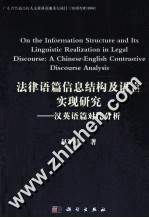

法律语篇信息结构及语言实现研究 汉英语篇对比分析PDF电子书下载
- 电子书积分:12 积分如何计算积分?
- 作 者:赵军峰著
- 出 版 社:北京:科学出版社
- 出版年份:2011
- ISBN:7030320956
- 页数:311 页
Chapter 1 Introduction 1
1.1 Introduction 1
1.2 Exploring the Nature of Legal Discourse Information Processing 2
1.3 A Corpus-Based Contrastive Study 6
1.4 Organization of the Book 8
Chapter 2 Information Bridges in Contrastive Legal Discourse Analysis 10
2.1 Introduction 10
2.2 Legal Discourse 11
2.3 Contrastive Discourse Analysis 16
2.4 Communication,Information and Discourse Analysis 19
2.4.1 Models of Communication 21
2.4.2 The Hallidayan Model of Discourse Analysis and Information Structure 26
2.4.3 Critical Discourse Analysis(CDA) 33
2.4.4 Appraisal Theory as an Approach to Tackle Interpersonal Meaning 35
2.4.5 Legal Discourse Information Structure 40
2.5 The Information Bridges in Contrastive Legal Discourse Analysis 47
2.5.1 Theoretical Foundings of Information Bridges Model 48
2.5.2 Description of the Analytical Framework 50
2.6 A Pilot Study 58
2.6.1 Introduction 58
2.6.2 Analysis Based on the Proposed Analytical Framework 60
2.6.3 A Tentative Conclusion 69
2.7 Summary 69
Chapter 3 The Socio-cultural System 71
3.1 Introduction 71
3.2 Overview:the Socio-cultural System 72
3.3 Social Measures 74
3.4 Ideologies 82
3.5 Power Relations 104
3.6 Summary 117
Chapter 4 The Linguistic Conventions 119
4.1 Introduction 119
4.2 General Contrasts Between Chinese and English 120
4.3 Lexical Choices 124
4.3.1 Verb-orientation vs.Nominalizations 125
4.3.2 Personal vs.Impersonal 131
4.3.3 Stative vs.Dynamic 135
4.4 Syntactic Structure 137
4.4.1 Topic-prominent vs.Subject-prominent 138
4.4.2 Active vs.Passive 141
4.4.3 Diffusive vs.Compact 143
4.4.4 Reiterative vs.Substitutive 146
4.5 Rhetorical Structure 151
4.5.1 Paratactic vs.Hypotactic 152
4.5.2 Direct vs.Indirect 156
4.5.3 Simplex vs.Complex 159
4.6 Summary 161
Chapter 5 The Legal System 163
5.1 Introduction 163
5.2 Overview:the Chinese Law vs.the Common Law 163
5.3 Legal Assumptions 168
5.3.1 Guilty Presumption vs.Innocent Presumption 169
5.3.2 Stare Decisis vs.Statutory Decisis 175
5.4 Institutional Features 182
5.4.1 Adversarial vs.Inquisitorial 183
5.4.2 Collegiate Panels vs.Jury System 188
5.5 Procedural Formalities 193
5.5.1 Interrogation vs.Interview 194
5.5.2 Mediation vs.Plea Bargaining 200
5.5.3 Judge Dominance vs.Lawyer Dominance 207
5.6 Summary 214
Chapter 6 The Discourse Users'Stance 216
6.1 Introduction 216
6.2 Affect 217
6.2.1 Basic vs.Complex 218
6.2.2 Authorial vs.Non-authorial 224
6.2.3 Behavioral Surge vs.Mental State 228
6.3 Judgment 232
6.3.1 Implicit vs.Explicit 233
6.3.2 Social Esteem vs.Social Sanction 237
6.4 Appreciation 243
6.4.1 Reaction:Impact vs.Quality 244
6.4.2 Composition:Balance vs.Complexity 249
6.4.3 Valuation 252
6.5 A Comprehensive Analysis of Attitude 256
6.6 Summary 259
Chapter 7 Implications and Prospects for Chinese-English Contrastive Studies and Legal Translations 261
7.1 Introduction 261
7.2 Summary of Major Findings 262
7.2.1 Determining Factors 262
7.2.2 For Optimal Legal Information Transmission 265
7.2.3 Similarities and Differences 266
7.3 Conclusion 270
7.4 Implications for Chinese-English Legal Translations 272
7.5 Limitations of the Research 274
7.6 Prospects for Further Research 275
References 277
Appendices 293
Appendix Ⅰ A Tagged Sample of an English Judgment 293
Appendix Ⅱ Tagged Sample of a Chinese Court Judgment 299
Appendix Ⅲ Tagging Symbols for the CLIPS 307
Appendix Ⅳ Tagging Symbols for Information Elements 310
- 《联吡啶基钌光敏染料的结构与性能的理论研究》李明霞 2019
- 《异质性条件下技术创新最优市场结构研究 以中国高技术产业为例》千慧雄 2019
- 《区块链DAPP开发入门、代码实现、场景应用》李万胜著 2019
- 《程序逻辑及C语言编程》卢卫中,杨丽芳主编 2019
- 《幼儿园课程资源丛书 幼儿园语言教育资源》周兢编 2015
- 《柏里曼人体结构绘画教学描摹本 第2册 头手足结构》杨建飞主编 2019
- 《高等学校“十三五”规划教材 C语言程序设计》翟玉峰责任编辑;(中国)李聪,曾志华,江伟 2019
- 《音乐语言的根基》张艺编著 2019
- 《英汉轻动词对比研究》朱乐奇著 2019
- 《认知语言学视野的抽象方位结构研究》曹爽著 2019
- 《深筋膜徒手松解疗法》盛德峰著 2019
- 《高校教师胜任力与工作绩效关系研究》曹志峰著 2019
- 《新媒体运营实战指南 社群运营 短视频运营 直播运营 微信运营》陈政峰著 2019
- 《物理化学实验》赵军,李国祥主编 2019
- 《如何成为学习高手》林泰峰著 2019
- 《中国学术思想研究辑刊 二十编 第9册 欧阳修《诗本义》研究新探 重估汉宋《诗经》学的转变与意义 上》陈战峰著 2015
- 《Python数据可视化 基于Bokeh的可视化绘图》屈希峰著 2020
- 《信息时代的哲学新问题=NEW PHILOSOPHICAL ISSUES IN THE INFORMATION AGE》肖峰著 2020
- 《中国学术思想研究辑刊 二十编 第7册 宋代《诗经》学与理学 上》陈战峰著 2015
- 《不器:我只是个生活家》何越峰著 2019
- 《指向核心素养 北京十一学校名师教学设计 英语 七年级 上 配人教版》周志英总主编 2019
- 《《走近科学》精选丛书 中国UFO悬案调查》郭之文 2019
- 《北京生态环境保护》《北京环境保护丛书》编委会编著 2018
- 《中医骨伤科学》赵文海,张俐,温建民著 2017
- 《美国小学分级阅读 二级D 地球科学&物质科学》本书编委会 2016
- 《指向核心素养 北京十一学校名师教学设计 英语 九年级 上 配人教版》周志英总主编 2019
- 《强磁场下的基础科学问题》中国科学院编 2020
- 《小牛顿科学故事馆 进化论的故事》小牛顿科学教育公司编辑团队 2018
- 《小牛顿科学故事馆 医学的故事》小牛顿科学教育公司编辑团队 2018
- 《高等院校旅游专业系列教材 旅游企业岗位培训系列教材 新编北京导游英语》杨昆,鄢莉,谭明华 2019
